|
|
|
|
|
|
|
|
|
The 'position light' form of main signal, which was used extensively in parts of North America, underwent limited trials in Britain. This signal was capable of displaying three aspects, each consisting of four lights in a straight line that mimicked a three-position semaphore arm. The angle of inclination determined the meaning of each aspect; horizontal for 'danger' [2.88], diagonal for 'caution' [2.89], and vertical for 'clear' [2.90]. As well as showing the same aspects at night as it did by day, the position light signal had the advantage that it completely eliminated colour. A disadvantage was its large size, comparable to that of a semaphore signal, which precluded its use in confined spaces such as tunnels. There was also a risk of misreading the indications at locations such as stations where a large number of white lights would be present for other purposes. One of these signals was installed at Willesden Green on the Metropolitan Railway in May 1918 for a trial in which it co-acted with an existing semaphore signal (see Section 7). A second example appeared on the L&SWR at London Waterloo in 1920, but use of the position light as a main signal failed to catch on in Britain.
 |
 |
 |
|
[2.88] Position Light Signal showing 'Danger'.
Area: Willesden Green, Met.R / London Waterloo, L&SWR Usage: Low Status: Historical |
[2.89] Position Light Signal showing 'Caution'.
Area: Willesden Green, Met.R / London Waterloo, L&SWR Usage: Low Status: Historical |
[2.90] Position Light Signal showing 'Clear'.
Area: Willesden Green, Met.R / London Waterloo, L&SWR Usage: Low Status: Historical |
|---|
The GWR's Ealing & Shepherd's Bush Railway opened in 1917, and the line was provided with three-position semaphore signals in 1920. Uniquely, those signals that worked automatically were distinguished by having a pointed arm with a matching white chevron [2.91 - 2.93]. A similar style of signal arm had been used for level crossing signals on the Dornoch Light Railway (see [16.7 & 16.8]).
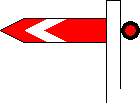 |
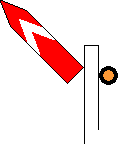 |
 |
|
[2.91] Automatic Three-position Semaphore Signal showing 'Danger'.
Area: Ealing & Shepherd's Bush Railway Usage: Low Status: Historical |
[2.92] Automatic Three-position Semaphore Signal showing 'Caution'.
Area: Ealing & Shepherd's Bush Railway Usage: Low Status: Historical |
[2.93] Automatic Three-position Semaphore Signal showing 'Clear'.
Area: Ealing & Shepherd's Bush Railway Usage: Low Status: Historical |
|---|
Gradually, all the other railway companies followed the example of the Great Central Railway in painting the arms of their distant signals yellow and fitting yellow lenses in place of the red (see [2.86 & 2.87]). On the Great Northern Railway, the yellow distant signals had vertical black stripes [2.94 & 2.95]. Other companies that used somersault signals put black chevrons on their distant signals [2.96].
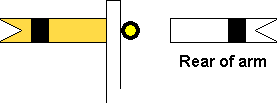 |
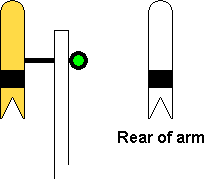 |
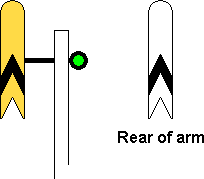 |
|
[2.94] Semaphore Distant Signal with Yellow Arm ('on').
Area: GNR Usage: High Status: Historical |
[2.95] 'Somersault' Distant Signal with Yellow Arm ('off').
Area: GNR Usage: High Status: Historical |
[2.96] 'Somersault' Distant Signal with Yellow Arm and Black Chevron ('off').
Area: Various Usage: High Status: Historical |
|---|
The earliest yellow distant signals on the London & South Western Railway had white chevrons on the front of the arms [2.97 & 2.98].
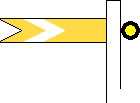 |
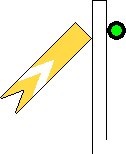 |
|
[2.97] Semaphore Distant Signal with Yellow Arm ('on').
Area: L&SWR Usage: Unknown Status: Historical |
[2.98] Semaphore Distant Signal with Yellow Arm ('off').
Area: L&SWR Usage: Unknown Status: Historical |
|---|
In June 1921, the Barry Railway experimentally painted the arms of four distant signals orange and replaced their red lenses with orange ones [2.99 & 2.100].
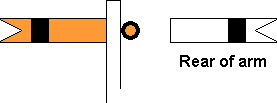 |
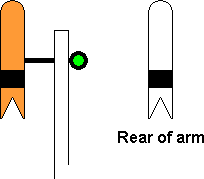 |
|
[2.99] Semaphore Distant Signal with Orange Arm ('on').
Area: Bar.R Usage: Low Status: Historical |
[2.100] Semaphore Distant Signal with Orange Arm ('off').
Area: Bar.R Usage: Low Status: Historical |
|---|
The ringed distant signals applicable to goods lines on the Southern Railway had their red arms changed to yellow [2.101 & 2.102].
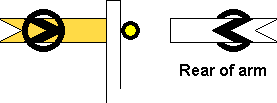 |
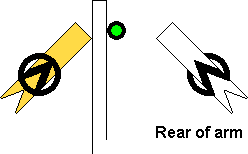 |
|
[2.101] Ringed Semaphore Distant Signal with Yellow Arm ('on').
Area: Southern Railway Usage: Low Status: Historical |
[2.102] Ringed Semaphore Distant Signal with Yellow Arm ('off').
Area: Southern Railway Usage: Low Status: Historical |
|---|
As an alternative to using banner type main signals in restricted clearance areas (see [2.74 & 2.75]), the Great Western Railway provided mechanical disc type main signals at Worcester Shrub Hill and Gloucester stations [2.103 & 2.104]. Nicknamed 'banjos', these signals were enlarged versions of disc shunting signals (see [4.46 & 4.48]).
 |
 |
|
[2.103] Disc Stop Signal ('on').
Area: GWR Usage: Low Status: Obsolescent |
[2.104] Disc Stop Signal ('off').

Area: GWR Usage: Low Status: Obsolescent |
|---|
Colour light signals display the same aspects by day and by night, and they are sufficiently compact to be accommodated even where space is limited. The first use of colour light signals in Britain was on the Liverpool Overhead Railway in July 1921, when two-aspect signals were installed. The Midland Railway replaced twenty-six semaphore signals at Derby station with eighteen two-aspect colour light signals in 1921. Colour light signals capable of displaying three aspects first appeared on a mainline railway in 1923, on the LNER line between London Marylebone and Neasden. This scheme was planned by the Great Central Railway in 1922, A F Bound being the engineer responsible. The three aspects corresponded to the night-time indications of the GCR's upper quadrant three-position semaphore signals (see [2.9, 2.83 & 2.84]). A red aspect means 'danger' [2.105], a yellow aspect means 'caution' [2.106], and a green aspect means 'clear' [2.107].
 |
 |
 |
|
[2.105] Red Aspect.
Area: All Areas Usage: High Status: Current |
[2.106] Yellow Aspect.
Area: All Areas Usage: High Status: Current |
[2.107] Green Aspect.
Area: All Areas Usage: High Status: Current |
|---|
|
In March 1922, the Institution of Railway Signal Engineers set up a committee to consider the question of three-position signalling and make recommendations as to the most suitable signal aspects. Its report, published in 1924, went further and recommended the introduction of a fourth aspect in colour light signals, for use in congested areas where a better headway was required. The new aspect was given the meaning "warning - be prepared to find the next signal at 'caution'". The recommended aspect was two yellow lights, one placed vertically above the other [2.108], although one yellow combined with one green had been considered. The new double yellow aspect was first used between Holborn Viaduct and Elephant & Castle on the Southern Railway, in March 1926. |
|
The Southern Railway perpetuated its special use of main signals for entering the platform roads at terminal stations, which it inherited from the LB&SCR. Where a colour light signal was used in this situation, a yellow aspect (see [2.106]) meant that the platform road was already partially occupied, while a green aspect (see [2.107]) meant that the platform road was unoccupied (i.e. clear to the buffer stop). The LMS implemented similar arrangements at Glasgow St. Enoch in May 1933.
|
|
|